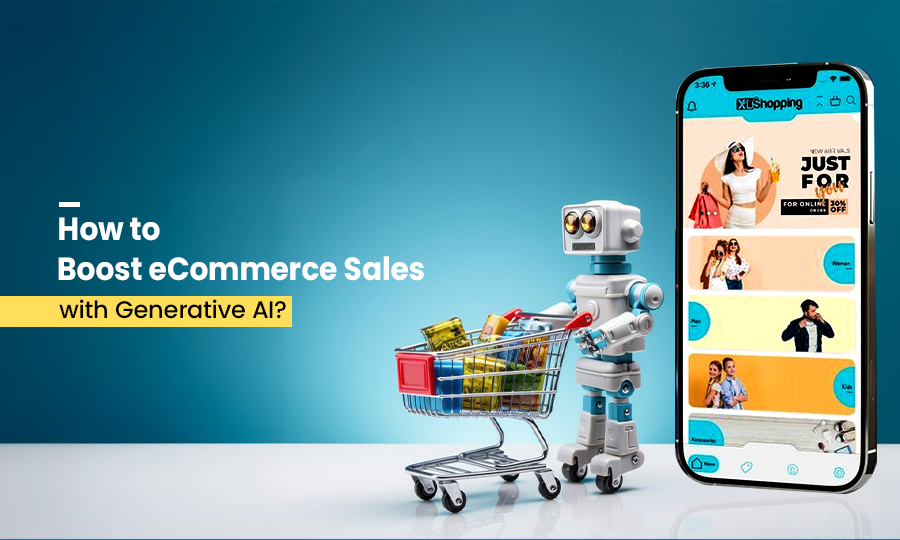eCommerce businesses of late leverage cutting-edge tools and technologies to boost their sales and revenue – generative AI is one of those. Generative AI in e-commerce has vast potential to boost sales and conversions in today’s fast-paced and competitive business environment. A report reveals that generative AI in the market is likely to reach up to $2.1 billion by 2032.
Incorporating generative AI in eCommerce lets you avail of numerous advantages such as customized and targeted marketing campaigns, dynamic pricing, personalized purchasing experience, and more. The major advantage of leveraging generative AI in eCommerce is it prevents users from exploring thousands of products manually.
Of course, picking up the right products from a plethora of options is time-consuming and leads to huge dissatisfaction. Users also need to use filters according to brands, sizes, types, etc.
On the other hand, generative AI leaves no space for dissatisfaction for users. The major advantage of leveraging this technology is its ability to suggest relevant products that enable users to make the right decision even within a short period.
Generative AI system asks a couple of questions to users to understand their tastes and preferences. Based on these questions, it suggests the right products for users matching their interests. It thus encourages more users to buy products and thus increases sales.s
In this blog, we will discuss complete information regarding how generative AI is useful in increasing sales in eCommerce.
What is Generative AI in e-commerce?
Generative AI in e-commerce indicates how retailers leverage Artificial Intelligence (AI). Be it personalized product recommendations, product descriptions, or marketing copy, eCommerce companies leverage the power of AI in several ways. The technology enables online retailers to automate repetitive and routine tasks, improve user experience, and deliver a fully personalized shopping experience.
Generative AI is capable of performing various tasks such as analyzing browsing patterns, customer emotions, preferences, purchase history, etc. This technology is capable of generating chat responses, engaging visuals, and more. It not only improves both customer engagement and efficiency but also increases conversion rates. It makes generative AI a powerful tool for growth and innovation in the eCommerce industry.
Reasons to Adopt Generative AI in eCommerce
As mentioned above, generative AI is completely different from AI. It has enough capabilities to perform several tasks like simulating customer interactions, content creation, and generating the latest solutions. Let’s explore several other reasons why generative AI is essential in eCommerce;
- Boost Operational Efficiency
Generative AI improves business operations through the automation of several repetitive tasks and maximizing workflow productivity. Right from inventory management prediction to creating product descriptions, AI has the capability of minimizing both the labor and time needed for several backend operations. It allows retailers to automate the process of content creation, generate dynamic pricing generative strategies, answer customer queries, and more.
- Automation
When it comes to automation, it has become mandatory in today’s competitive and fast-paced digital commerce world. Generative AI allows smart automation, apart from just being rule-based tasks.
Powered by AI, chatbots have the capability of handling even complex customer inquiries whereas tools including AI-based email campaign generators craft personalized messages according to customer behavior. This automation not only minimizes human dependency but also ensures consistency and scalability in the entire business processes.
- Personalization
Another promising advantage of generative AI is it has the capability of offering a personalized experience, which matters a lot in improving user experience. Artificial Intelligence has the capability of analyzing customer behavior, browsing history, demographic data, and more.
Based on these, AI produces more custom product recommendations, targeted marketing content, curated customer journeys, and more. Personalization yields numerous benefits like improved conversion rates, higher customer engagement, increased customer loyalty, and more. It provides retailers with a complete competitive advantage.
- Improve Customer Experience
An improved and personalized customer experience is indeed important for the success of any e-commerce business in the long-term. Generative AI improves this by providing intelligent and real-time support with the use of virtual assistants and chatbots.
These AI-driven tools have an immense understanding of answering questions, understanding natural language, and resolving various issues with a higher efficiency. Whether it’s sizing guides, AI-generated product visuals, or AR simulations, these allow shoppers to make a highly informed purchasing decision. It minimizes overall return rates and ensures higher customer satisfaction.
- Data-Based Decision Making
Generative AI enables retailers to access an extensive customer data, which they can leverage to produce meaningful business intelligence. Right from customer sentiment analysis to demand forecasting, AI tools allow eCommerce business owners to make strategic decisions. It encourages businesses to make smart choices related to marketing, inventory management, customer engagement, pricing, and more.
How Generative AI helps in Increasing eCommerce Sales
As we already talked, generative AI has unmatched potential to boost your eCommerce business ROI. We will discuss how generative AI boosts sales of eCommerce companies.
- Personalized Product Recommendations

As we already mentioned, the major advantage of using Artificial Intelligence in eCommerce is it has an immense capability of hyper-personalizing content. The tailored content of course works effectively in improving the shopping experience of potential customers.
So, you may be excited to know how AI hyper-personalized content, right? Well, we have discussed here various ways to help you know;
Data Collection and Process
In this step, AI gathers user shopping data and processes it properly. Artificial Intelligence gathers users’ data from your online store and then focuses on the following important factors;
- Purchase history
- User behavior
- Demographic profile
Training AI Model with Collected Data
One thing you need to remember, it’s not possible to use Artificial Intelligence without training it. Once you train it properly, you will be able to harness its full potential advantages. You can achieve it easily by opting for an AI development service that brings the possibility of training AI models including ChatGPT and Generative AI with the use of the collected data.
Choose the Right Product Database
In this step, you need to ensure that the system includes the appropriate and detailed product database.
Personalized Product Recommendation
The system includes the capability of generating personalized product recommendations according to the collected customer data.
Provide Product Suggestions Based on Users’ Choice
This step involves the presentation of product suggestions tailored to match the specific preferences of customers. Be it generative AI algorithms or Machine Learning, they both have vast potential to analyze customer data including purchase history, browsing behavior, demographics, and wish list items.
Generative AI leverages this customer data to customize product recommendations according to the past customer interaction history, previously explored items, latest product views, and more. Apart from this, it also takes into account many market trends such as products and seasonal preferences that are purchased more frequently together.
For instance, you can easily view the ‘Recommended for You’ section by Amazon. It’s the best example of AI-driven personalization by suggesting the right products to those of many individual shopper profiles. It impacts positively on both user experience while enhancing customer engagement.
We will understand personalized locations by another example as well.
Suppose a customer named ‘David’ is looking to buy sunglasses from an eCommerce store. With a traditional store, they can come across several options with different brands, colors, etc.
To choose the right option, David needs to filter manually to select based on his preferences and also spend time browsing with the help of shoes. David may be confused to make the right selection with proper guidance.
As a result, he becomes frustrated and finally leaves your website without completing the purchasing process. This boosts the abandonment rate on your shopping cart.
Enter AI-Improved eCommerce Shopping
In this situation, David needs to answer several questions related to his brand preferences, style, colors, etc. With the use of these details, generative AI presents a vast collection of shoes tailored to match your requirements and also to give you a fully personalized experience.
This approach is something that works effectively to keep David engaged since he feels the online store understands his needs. It lets David get a feeling that the eCommerce store has a full understanding of his actual needs. And he can easily find and purchase sunglasses. It ultimately increases sales and ROI.
As per recent stats, approximately 40% of marketing experts believe that customer personalization has a direct impact on basket size, eCommerce sales maximization, profit, and others.
Generative AI algorithms in eCommerce stores analyze various important details like purchasing history, customers’ browsing behavior, demographic data, and other important data. They also include details like abandoned products in the cart and wishlist items.
Generative AI technology leverages the following important data to help users get the right products customized to match their individual customers’ needs.
- Customers’ past interaction or purchasing on the eCommerce application or website.
- Customer’s recent product interaction
- Customer’s previously viewed products or items
- Use Dynamic Pricing and Personalized Ads

It’s known to all that customers always track and then make a detailed comparison of product prices online or in-store. With generative AI, eCommerce businesses can easily discover ways of setting product prices.
When it comes to dynamic pricing, it’s also referred to as time-based pricing or surge pricing. It’s an important type of marketing strategy that enables businesses to adjust pricing with full flexibility for their products or services according to the present market conditions.
It leverages AI-driven predictive analytics to analyze data, be it inventory levels, customer behavior, or competitor prices. These are indeed useful to make an informed decision. To understand the dynamic pricing, we can take the example of Uber! It often adjusts its ride costs based on several factors such as heavy rains, peak traffic hours, and more.
In the same way, eCommerce leverages the potential benefits of dynamic pricing. It allows you to provide lucrative discounts even during slow periods or increase costs, especially during the peak demand. It boosts your ROI.
For instance, during the winter season eCommerce businesses can increase prices, including socks, coats, cardigans, mufflers, and more at a higher rate with the increasing demand. It also decreases gradually with the progress of the season. It will increase conversion and thus overall revenue.
Quite the contrary, if any items witnessed a significant decrease in their sales, you can minimize their prices to boost sales. It also helps you clear your inventory as fast as possible. This price optimization allows you to get a competitive edge and thus improve your overall revenue while matching your customer preferences.
Apart from this, running personalized ads with the use of AI-driven marketing is effective in offering a highly engaging shopping experience. You need to leverage the data gathered by your eCommerce store, through generative AI for crafting several personalized marketing materials.
These discounts and offers appear as pop-ups on the website, newsletter banners, and app notifications. These lure customers to purchase those products that they have reflected their desire to buy. Besides, this kind of targeted approach helps increase the additional boost in sales and also potentially a bigger basket size thus increasing ROI.
You need to always keep in mind that customers often spend a lot of time finding the best deals before purchasing any products. With the use of generative AI, businesses stay informed about this and thus can adjust their prices based on the market conditions including inventory levels, demand, and more. It helps them stay competitive.
eCommerce organizations can maximize the return on investment by increasing costs with higher demand, including festivals, and also offer discounts during less demand. They need to focus on those items that have a slower demand even during the lower price to clear stock.
Apart from this, Artificial Intelligence also has the capability of generating various customized advertisements and offers, including coupons for products. These of course boost purchases, sales, and thus return on investment.
- Leverage the Power of Chatbot and Personalized Content
AI chatbots are indeed quite beneficial for your eCommerce store. It allows users to submit pictures to recreate celebrity looks and offer more tailored advice. So, the customized strategy works effectively to boost revenue while ensuring more client retention.
Buyers grab various opportunities to imagine products before they shop finally. They can do it with the help of generative AI virtual try-ons that leverage the power of AR to offer a complete realistic shopping experience. This feature is important to improve customer’s confidence and online shopping experience by minimizing return rates.
AI-powered chatbots have the capability of improving product discovery by predicting the customer’s demand. Apart from this, AI chatbots have an unmatched capability of customizing product recommendations according to several factors like color style, size, price range, brand, and more. It leverages the power of recommendation algorithms. To boost consumer interest and purchases, they offer upselling and cross-selling alternatives.
As we already mentioned, generative AI has the capability of generating numbers of product descriptions while ensuring it is interesting and SEO-optimized. Artificial Intelligence ensures product descriptions that focus on various features like eco-friendliness, by determining customer data and preferences. It ensures successful targeting of specific customer categories and boosts click-through rates, conversion, and ROI.
It’s pivotal to form an eCommerce ecosystem that can grasp and anticipate every customer’s requirements. And the way of doing the same is to integrate an AI-driven chatbot to boost product discovery.
As per Salesforce, 82% of businesses witnessed moderate improvement with the use of AI, in terms of the way customers discover, explore, and engage with products. Chatbots use smart recommendation systems to offer customized product suggestions.
Besides, it also offers various styling ideas by asking numerous questions related to product color, size, brand, style, and budget. It suggests various upselling or cross-selling options, which lure customers to a higher extent than they purchase.
Apart from this, AI chatbots have the power to personalize every important message and thus answer queries with human-like emotion. For instance, if users wish to recreate outfits of their favorite celebrities, they don’t need to spend time exploring several products. Instead, they need to upload an image of the outfit and let the chatbot recommend the same kinds of outfits for them.
It indeed increases sales and thus ensures higher customer loyalty. Apart from this, generative AI virtual try-ons have gained enormous popularity for offering an accurate and immersive eCommerce shopping experience. To use this feature, users can use a desktop webcam, mobile device video, etc.
Many e-commerce retailers of late use the’ AI virtual try-ons’ feature and claim a great improvement in user experience, sales, and revenue. For instance, Being a renowned watch seller, Baume & Mercier also uses a virtual try-ons feature on their website. It allows customers to try watches virtually and see how it looks.
Of course, trying products even virtually boosts a lot of confidence in customers and thus prompts them to buy products. It also minimizes the chance of returning products and thus works effectively in saving time as well as delivery costs.
- Product Description
Since an eCommerce store sells several products online, writing a description of each product is indeed a time-consuming process. As we mentioned, generative AI works effectively in automating the entire process by generating unique and quality product descriptions.
It has the capability of analyzing customer feedback, features, competitor listings, etc. to generate top-quality descriptions that resonate effectively with the target audience. It indeed helps in enhancing the organic visibility of products in search engines and also has significant improvements in conversions by providing persuasive and clear product information.
The AI-generative description offers consistency in both style and tone across the entire catalog, creating customer trust, and more. The major benefit of a well-written description is it easily draws buyer’s attention and thus has a direct influence on their buying decision.
Meanwhile, you can also use A/B testing to revamp even those descriptions written by AI. It helps you determine those products that perform outstandingly. It also helps you fine-tune your content for a higher conversion.
How to Write Product Descriptions through Generative AI?
The entire process of writing a product description involves multiple steps. Let’s take a look at every step in-depth;
- Gather Product Information
Before you leverage any tool for writing product descriptions, you need to gather important details related to your products. The information includes several things such as features, category, product name, benefits, specifications, target audience, and more. Once you gather every important detail, it helps you shape up the output easily. To get better results, you need to provide more context.
- Selection of the Right AI Tool
While choosing the right AI tool, you will come across several available tools. ChatGPT is one of those. It’s popular for having higher flexibility and also conversational writing. Apart from this, many other AI tools also gained huge popularity, including Copy.ai, Jasper.ai, Writesonic, and more. These AI tools are designed mainly for marketing content and may include several pre-built templates for product descriptions.
- Write Prompts Clearly
The most important thing you need to do is to write some specific prompts. For instance, you can include prompts like “Create a 70-word description for ‘Water Cooler’ by highlighting its design, color, eco-friendliness, features, and more. Use a persuasive and friendly tone.”
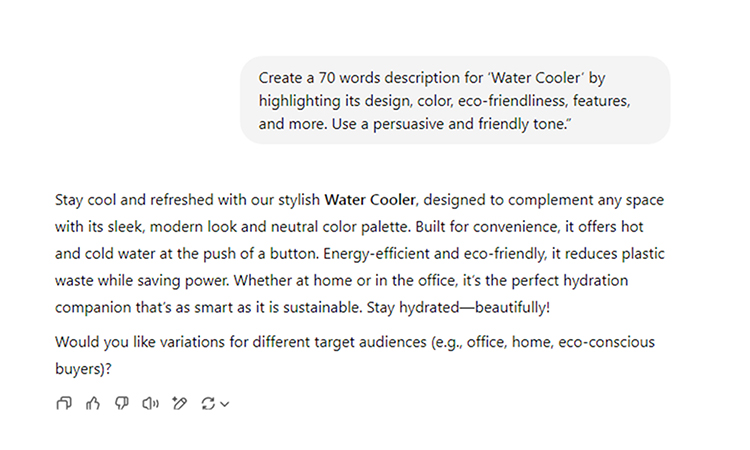
- Review and Refine
You need to understand that AI is not infallible, though it generates quality content. So, you should never forget to review and refine the generated description;
- You need to ensure factual accuracy
- You need to ensure unique selling points
- You need to maintain a consistent brand voice
- Correct grammar
- Add SEO Elements
It’s necessary to implement the right keywords into your descriptions to maximize search visibility. You need to leverage tools such as Ahrefs, Google Keyword Planner, etc., to discover various search terms your audience uses. It’s necessary to use keywords naturally in the content even without overstuffing.
- A/B Test and Optimize
It’s advisable to create a multiple version of the product description. After this, you need to test the right one that performs tremendously in increasing engagement and conversion. You need to understand that even small modifications in works tend to make the biggest differences.
- Improve Supply Chain and Analytics
Generative AI plays an indispensable role when it comes to increasing supply chain management efficiency. It has an unmatched ability to process vast amounts of customer demand trends, historical sales data, etc.
Besides, it also analyzes several external factors like market fluctuation, weather, and others to produce valuable insights. These insights are indeed use to predict demand of customers, overstocking, stockouts, minimizing instances, and more.
Apart from this, generative AI models have the capability of simulating several logistics scenarios and thus suggest various optimal inventory distribution strategies. It results in minimized shipping costs, quick delivery times, etc. Generative AI models finally ensure an increased customer satisfaction. It indeed increases sales. When it comes to data analytics, it has been an important driver in eCommerce and also with Generative AI.
AI produces in-depth reports and also actionable insights by analyzing factors like purchase history, customer preferences, behaviors, and more. Moreover, chatbots possess the capability of offering tailored customer support, guiding customers, and answering their queries throughout their purchasing journey.
How Generative AI Improves Supply Chain and Analytics in eCommerce?
- Forecasting Demand
As we already mentioned, generative AI analyzes a large volume of datasets to produce demand forecasts while maintaining a higher accuracy. It offers numerous advantages;
- It minimizes stockouts and overstock
- It reduces the holding costs
- It enhances just-in-time inventory systems
- Automate Scenario Planning
Generative AI ensures automated scenario planning in multiple steps. These include;
- It predicts various factors that have the potential to impact supply chain disruptions, including labor shortages, delays, etc.
- It can easily discover those logistic options that are cost-effective.
- It produces adaptive strategies according to changing market conditions.
- Supplier Relationship Optimization
Generative AI also plays a vital role when it comes to improving supplier performance. It produces necessary insights or even various alternative sourcing strategies. It helps your businesses in several ways;
- Select reliable suppliers
- Minimize risks through diversification
- Automate procurement and contract processes
- Personalized Logistics and Fulfillment
AI-based models are useful to customize delivery schedules by considering the following important factors;
- Geographic data
- Customer preferences
- Weather updates
- Real-time traffic
- Improved Analytics and Reporting
For improving reporting and analytics, generative AI helps in the following ways;
- It produces dynamic dashboards
- It generates performance reports
- It detects issues in supply chain data
- It suggests corrective actions even in real-time as well
- Visual Content Creation
Today’s marketplace is visually driven. So, make sure you use top-quality product videos and images. Generative AI tools have the capability of creating realistic images, generating lifestyle product visuals, modifying existing ones, etc. even without any traditional photography.
For instance, if you sell apparel through your eCommerce store, you need to focus on showing different environments or also different body types. Generative AI has the power to boost these scenarios quickly while maintaining cost-effectiveness.
Artificial Intelligence is useful in creating 3D product models. They indeed improve the interactive shopping experience. These models not only draw customers’ attention but also maximize engagement, minimize return rates, and improve conversion rates.
How Generative AI Helps in Visual Content Creation
To generate visual content, you need to go through the following important steps;
- You need to first define your core objectives like branding, marketing, education, entertainment, etc. It’s essential to clarify the type of visual, including infographic, video, image, artwork, and more.
- You need to select the right generative AI tool. For image creation, you can either go with Adobe Firefly, DALL E, Midjourney, Runway ML, etc. On the other hand, you can opt for Pika Labs, Runway, or Synthesia for video generation. Choose either Adobe Express AI or Canva AI for design. And Meshy AI and NVIDIA Omniverse for 3D models.
- Now, it’s time to create prompts in detail in terms of what you wish the AI to produce. Make sure your prompts include everything properly, be it color scheme, mood, subject, style, or layout details. For instance, your prompt should be like “Create an Image on futuristic women’s apparel with beautiful embroidery work, stylish sleeves, necks, and more.”
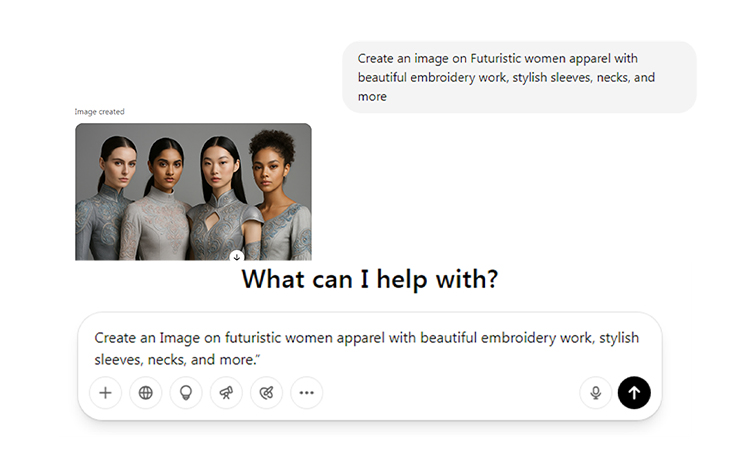
- You need to create a resolution in terms of style strength, aspect ratio, etc.
- You need to select seed values for reproducibility.
- It’s important to determine the overall output for quality, aesthetics, and accuracy.
- If you are not satisfied with the final results, you can review your prompts for improved outcomes.
7. Summarization of Customer Review
It’s another challenge that most eCommerce service providers come across. Generative AI has the capability of analyzing several reviews and offering concise summaries while maintaining a higher accuracy. It indeed highlights common sentiments, pros and cons of products’ frequently mentioned issues or features.
With these summaries, potential buyers can grasp overall sentiment even without reading every review. It allows them to speed up the entire process of decision-making while minimizing the cart abandonment rates.
For many businesses, summarized reviews are beneficial in getting details of product performance, customer pain points, potential areas of improvement, and more. You can leverage this feedback loop to refine products, optimize listings, and boost customer service. These all contribute effectively to increasing sales.
Steps to Summarize Customer Review
Let’s understand several steps to doing it effectively;
- Decide your Goal First
You need to decide about the type of summary you require, whether it’s an abstractive summary, extractive summary, thematic summary, or sentiment-based summary.
- Gather Data
Collect vital data, including customer reviews from multiple platforms like Trustpilot, Google Reviews, and internal feedback forums.
- Select Right Tools
Now, you need to opt for the right tool or model based on summarization. For instance, you can opt for abstractive summarization and nuanced interpretation for ChatGPT AI. Hugging Face Transformers can be the right option for customizable and offline solutions. On the other hand, for business-scale solutions, you need to opt for NLP/AutoML platforms.
- Create Prompts
Always use well-created prompts that garner better outcomes. You can create either basic, thematic, or sentiment-aware responses;
For basic, you can create a prompt including ‘Summarize Following Customer Reviews’. You can include at least 3 reviews.
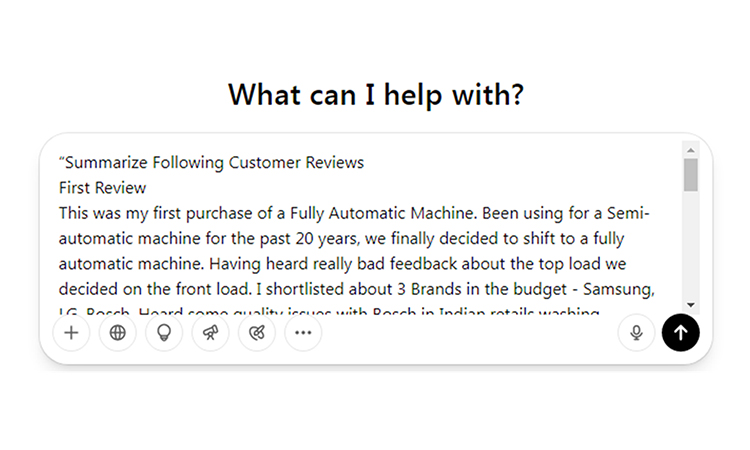
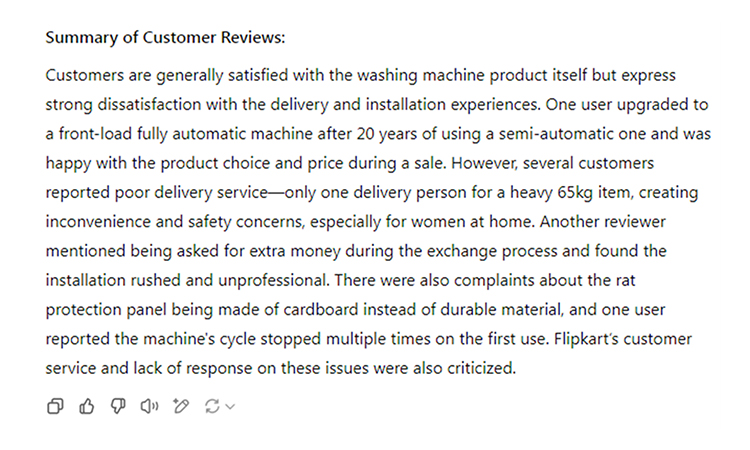
Focus on Output Format
You can choose the format of the summary based on your requirements;
- Bullet Points
- Visual Charts
- Paragraph Summary
- Integrate with Workflows
- You need to add summarization to the customer service dashboard
- Utilize summaries for creating monthly feedback reports
- Automate Affiliate and Influencer Outreach
Affiliate programs and influencer marketing are the most reliable techniques to boost traffic and sales. But, when you search for influencers manually, it can indeed be a time-consuming task. One can automate the entire process with the help of generative AI.
With the use of machine learning (ML) and natural language processing (NLP), generative AI tools have the capability of scanning blogs, social media platforms, and content sites. And thus help you find influencers whose followers have the potential to be your customers. These tools have the capability of generating personalized outreach messages.
Tips to Use Generative AI to Outreach Influencers
- Choose right influencers
- Create personalized outreach emails
- Create influencer’s brief
- Content ideas from AI
- Summarize influencer campaign results
Prompts to Use for Influencer Outreach
For instance, you can use a prompt like ‘Create a campaign brief for Fashion YouTuber promoting ethnic apparel for women. Also highlight style, color, etc., with some content ideas.”



Most Popular Generative AI Tools for eCommerce
After going through the above discussion regarding the potential of generative AI in increasing sales, you may be keen to know several tools, right? Well, we have explained here some of the popular tools that e-commerce businesses leverage most frequently;
- ChatGPT
While talking about popular generative AI tools, it’s important to start with ChatGPT, which is one of the most sought-after tools. It’s a versatile AI language model that produces content and answers users’ queries in a human-like manner. eCommerce marketing professionals use this tool for several purposes like creating social media captions, and blog posts, responding to customer queries, etc.
- Synthesia
Synthesia is a video creational platform that facilitates videos and ads of any products even without filming. To generate video through this, one needs to just put text. It generates videos like AI avatars and voiceovers. This tool is useful for various purposes such as creating how-to-guide, product demos, localized ads, and more.
- GorgiasAI
GorgiasAI leverages natural language processing when it comes to analyzing various support tickets and resolving common inquiries with accuracy and empathetic responses. It can take actions in various eCommerce systems whether it’s processing refunds or checking order status. Based on these, the tool takes final actions.
- OctaneAI
OctaneAI is useful for eCommerce businesses to create customized quizzes, which ask shoppers to share their preferences. Based on this information, the tool provides tailored product recommendations. It syncs various collected quiz data with several marketing tools for customer segmentation follow-ups.
Conclusion
Generative AI has revolutionized the way eCommerce operates, serves customers, sells products, etc. In these ways, the tool maximized sales and revenue and thus helped eCommerce retailers grab various growth opportunities. To leverage the unmatched potential of generative AI, you need to use the right tool with the proper strategies. As a result, you will be able to save time, boost overall customer satisfaction, and thus get benefits from incremental revenue.
Additional Resources:
- How Generative Engine Optimization (GEO) Is Changing the Future of Search?
- What Is the Difference Between SEO And GEO Marketing?

